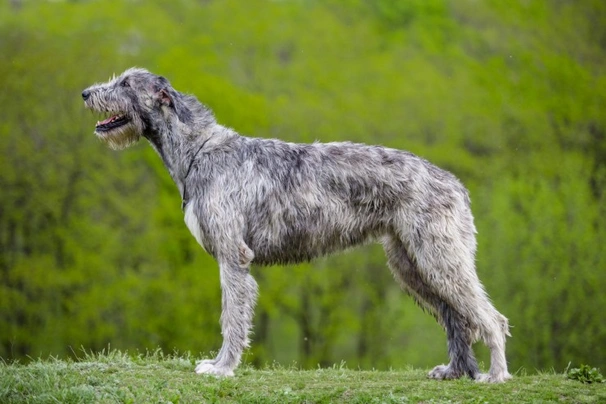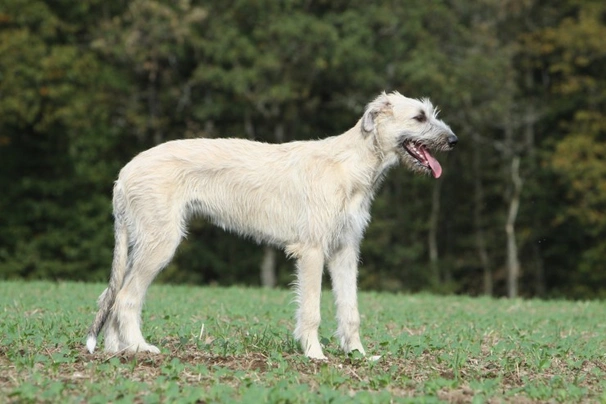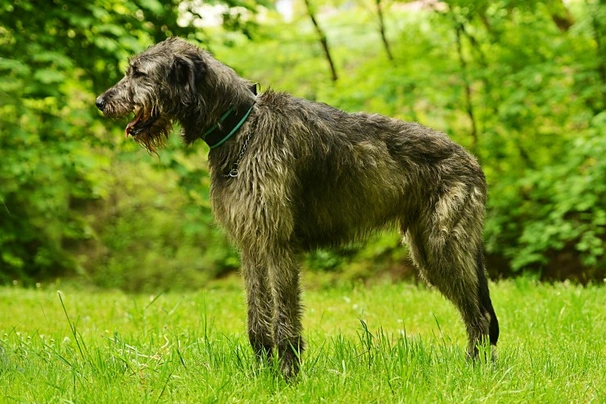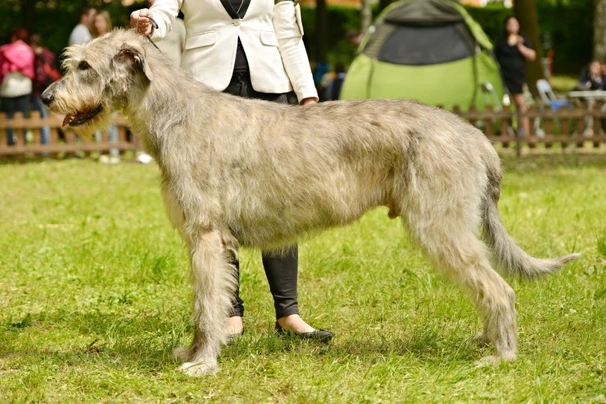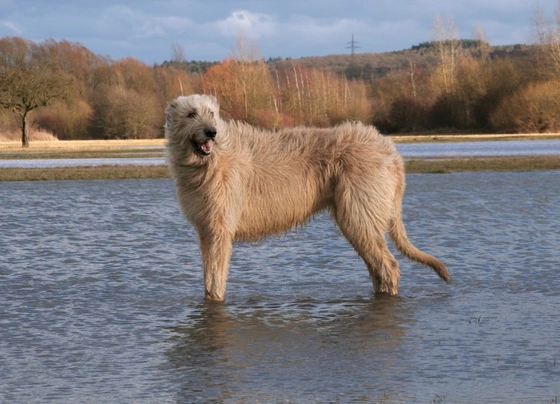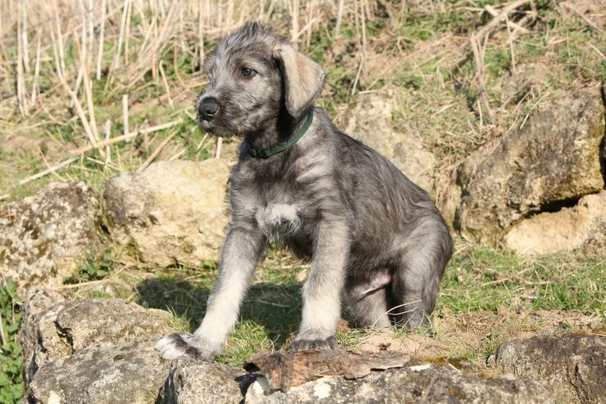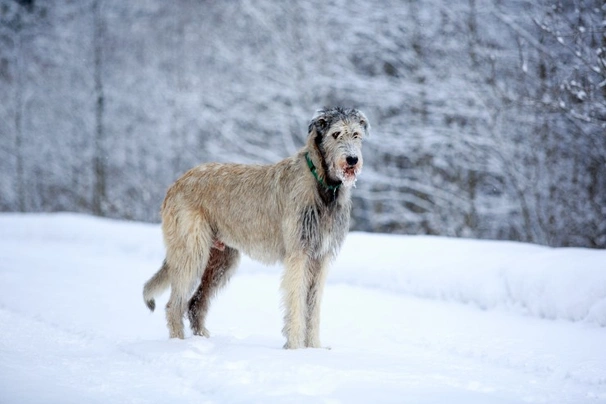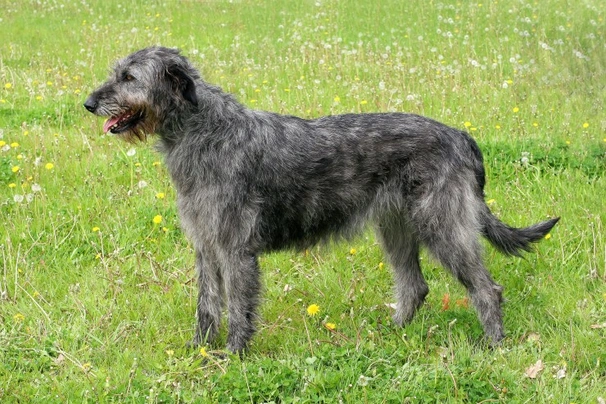Irish Wolfhound
Pros
Cons
Introduction of the Irish Wolfhound
The Irish Wolfhound is renowned as one of the tallest and most majestic of all hound breeds, embodying the essence of a gentle giant with a calm and relaxed temperament. Their impressive stature is paired with a harsh, rough coat that complements their noble, balanced appearance, making them truly striking companions. These dogs, though commanding in presence, are especially affectionate and kind towards children, making them beloved family pets for experienced dog owners who understand their unique requirements.
Originally bred for hunting and guarding, modern Irish Wolfhounds primarily serve as companions and gentle protectors, maintaining their sighthound agility and speed. They require owners who can provide ample exercise and mental enrichment to channel their natural instincts. Living with an Irish Wolfhound means accommodating their size with sufficient space and understanding their sensitive nature, which demands consistent socialisation and training from handlers familiar with such a giant breed.
Prospective owners should anticipate a commitment to care that includes daily exercise, grooming to maintain their coarse coat, and specialised feeding routines to support their rapid growth and large frame. This breed suits those with a spacious home, ideally in rural or suburban settings, who can offer dedicated time and attention. While not suited for novice dog owners, the Irish Wolfhound’s gentle disposition and loyalty reward those who can meet their needs with an incredibly loving and devoted companion.
Perfect For
Experienced owners or families familiar with large sighthounds who have the space and lifestyle to accommodate a very large breed. Suitable for homes with large, secure gardens and owners who can provide regular exercise and social interaction. Ideal for those seeking a calm, gentle giant companion with moderate to high activity levels but who also appreciates relaxed downtime.
Key Considerations
Needs early socialisation and consistent training to manage their high prey drive and sensitive temperament. Requires sufficient indoor and outdoor space due to their considerable size. Their exercise needs are high, necessitating around two hours daily. Potential health issues linked to their size should be acknowledged, alongside the financial commitment for premium food, vet care, and occasional professional grooming. Not suited for households with small pets due to strong chasing instincts.
History of the Irish Wolfhound
Dating back to around 7000 BC, the Irish Wolfhound is one of the world's most ancient dog breeds and the largest among hounds. Originally named "Cu" in ancient Irish, translating to hound, war dog, or wolf dog, these majestic dogs were chronicled in early Irish laws prior to Christianity and featured extensively in 5th-century Irish literature.
Early Development
Historically a prized possession of Irish royalty and nobility, Irish Wolfhounds were used in war to drag enemies off horses and chariots and to protect livestock. Their hunting prowess extended to tracking elk, deer, wolves, and wild boar. Their value was so esteemed that they were gifted to foreign dignitaries, including the King of Wales in 1210 AD and various European monarchs. However, intense demand nearly led to their extinction by the mid-17th century, prompting protective breeding bans. The breed's decline accelerated once wolves were eradicated from Ireland by the late 1700s, leading to a shift towards companion roles and the introduction of breeds like the Great Dane and Borzoi to restore their size and characteristics.Modern Recognition
Major breeders such as Major H. D. Richardson and Captain George Augustus Graham undertook restoration programmes in the 19th century, successfully re-establishing the Irish Wolfhound’s stature and qualities using diverse bloodlines. Despite setbacks during the World Wars, breed enthusiasts revived the population, culminating in the establishment of the Irish Wolfhound Club in 1885. The breed was officially recognised by The Kennel Club in 1925, and later by the Irish Wolfhound Society in 1981. Today, the Irish Wolfhound remains an emblematic Irish breed, treasured worldwide though still rare, with annual puppy registrations remaining low, often requiring prospective owners to join waiting lists.Appearance of the Irish Wolfhound
Size and Build
The Irish Wolfhound is the tallest of all hound breeds, boasting a commanding stature with males and females both standing between 71 and 90 cm at the withers and weighing between 40 and 69 kg. They possess a long, muscular and balanced frame giving an impression of grace and power, characterised by a long back, well-arched loins, and muscular thighs. Their feet are large, round with well-arched toes and strong curved nails, supporting their heavy bodies elegantly.
Coat and Colours
The breed features a harsh, wiry coat that is rough to the touch, covering the body, head, and legs with distinctive longer wiry hair around the eyes and under the jaw. Accepted colours according to The Kennel Club include black, black brindle, brindle, cream, dark brindle, fawn, grey, grey brindle, red, red brindle, wheaten, and wheaten brindle, offering a wide palette consistent with the breed standard. Seasonal shedding is moderate, with shedding peaks typically in spring and autumn.
Distinctive Features
The Irish Wolfhound’s head is long and carried proudly high, with a long, moderately pointed muzzle, black nose and lips, and full, oval-shaped dark eyes that convey intelligence and kindness. Their small rose-shaped ears, velvety in texture, are carried away from the face, complementing the breed's dignified expression. They have powerful jaws with a perfect scissor bite. The tail is long, thick at the base, slightly curved and carried low, enhancing their regal silhouette. Their gait is balanced, smooth, and effortless, underlining their sighthound heritage.
Gender Differences
There is little distinction in height between males and females, both reaching similar ranges, though males tend to carry more muscle mass and weight. Temperamentally, males may show more dominance tendencies, while females often exhibit a gentler, more reserved disposition. Size and build must conform closely to the breed standards to succeed in show rings, with faults heavily penalised if they affect health or functionality.
Temperament of the Irish Wolfhound
The Irish Wolfhound is renowned for its remarkably gentle and calm nature despite its impressive size. These dogs exhibit kind-hearted, friendly behaviour, making them excellent companions for families and individuals accustomed to handling large breeds. Their disposition is patient and affectionate, particularly with children, though their size necessitates careful supervision to prevent accidental injury.
They display a natural tendency towards a relaxed pace, rarely rushing their movements but capable of bursts of speed exhibiting their sighthound agility. This breed requires a significant amount of daily exercise to maintain physical health and mental stimulation; without it, they may develop behavioural issues stemming from boredom. Their prey drive is intrinsic, meaning they have a strong instinct to chase smaller animals and should never be trusted around small pets or livestock.
Socially, Irish Wolfhounds form close bonds with their owners and thrive on companionship. They exhibit some wariness towards strangers but are not aggressive, rather tending to be aloof or reserved. They are not natural watchdogs due to their friendly disposition and generally do not bark excessively. However, separation anxiety can develop if left alone for long periods, leading to destructive behaviour as a coping mechanism.
Due to their size and temperament, they are not recommended for first-time dog owners as they require consistent socialisation, patient training, and experienced handling to flourish. When well cared for, their playful puppy phase adds a light-hearted charm to their character, though play is best conducted outdoors to minimize accidental damage indoors.
Intelligence / Trainability of the Irish Wolfhound
The Irish Wolfhound is intelligent yet sensitive, requiring an approach to training that is grounded in gentleness and patience. Early training is essential, beginning with basic obedience commands such as "sit," "stay," "come," "heel," "quiet," and "leave it," all delivered using positive reinforcement methods such as treats, praise, and toys. Training sessions should be brief and engaging, avoiding over-repetition which can lead to boredom given the breed’s disposition.
Puppy Training Priorities
From the outset, owners should focus on socialisation, exposure to varied environments, and establishing clear boundaries and rules to help the puppy understand behavioural expectations. Ground rules help maintain a harmonious household and establish leadership without harsh corrections. House training is usually straightforward, as Irish Wolfhounds tend to be naturally clean.Training Methods That Work
Positive reinforcement combined with consistency proves most effective. The breed responds poorly to shouting or punitive approaches, which can cause stress and regressions. Gentle encouragement and short, frequent lessons help maintain attention and improve learning outcomes. Early leash training with a sturdy harness is recommended to manage their size and strength safely.Advanced Training Potential
While not typically used in competitive obedience or working roles, Irish Wolfhounds can excel in obedience, rally, or therapy work when training is tailored to their calm and sensitive nature. Their speed and endurance also suit activities such as lure coursing and tracking, demonstrating their working hound heritage.Common Training Mistakes
Owners often either rush training or lack consistency, which leads to confusion. Given their size, late intervention to correct undesirable behaviours like jumping or pulling can be challenging. It's crucial to begin training early and maintain routines to avoid habit formation. Reliance on harsh corrections should be avoided entirely.Children and other
The Irish Wolfhound makes an excellent family pet for those accustomed to large dog breeds and their specific needs. Their gentle and calm temperament means they generally coexist well with children, displaying patience and affection. However, the breed's considerable size means supervision is paramount, especially around toddlers and young children to prevent accidental injury during play or movement.
While Irish Wolfhounds typically get along well with other dogs, care should be taken when introducing them to smaller pets or cats, given their high prey drive and instinct to chase. Teaching children proper interaction techniques with the dog—such as gentle petting, respecting the dog's space, and understanding body language—is essential to fostering safe and positive relationships.
Creating safe environments includes providing escape spaces for the dog when they need rest and ensuring children understand the importance of not disturbing a resting dog. Particularly in households with young children, constant adult supervision during interactions is advised to maintain both safety and harmony. The breed's loyalty and protective nature also mean they often watch over family members attentively.
Health of the Irish Wolfhound
The Irish Wolfhound has a life expectancy generally between 6 and 8 years, which is typical for giant breeds, though recent studies indicate an average closer to 9.9 years with modern care. Owners should be aware of breed-specific health issues, particularly those related to their large size and genetics.
Health concerns known in the breed include hip and elbow dysplasia (with mean scores of 6 and 0 respectively), dilated cardiomyopathy (DCM), osteosarcoma (bone cancer), von Willebrand's disease, epilepsy, autoimmune diseases, gastric torsion (bloat), and Wobbler syndrome. Hyperekplexia is present in some lines and can be tested through DNA screening. Regular heart screenings and eye tests for conditions like retinal dysplasia and progressive retinal atrophy are encouraged.
Responsible breeders participate in health schemes mandated or recommended by The Kennel Club and breed societies, including hip and elbow scoring, annual heart tests, genetic screenings, and liver shunt testing. Maintaining genetic diversity remains a priority to reduce inherited disorders. Neutering and spaying are advised with veterinary guidance, often between 6 to 12 months of age.
Owners need to monitor weight closely to avoid obesity, which exacerbates joint and heart problems. Vaccinations should be kept current following professional veterinary schedules. Special attention during a dog’s senior years includes dietary adjustments, joint supplements, and regular vet check-ups to maintain quality of life.
Caring for the Irish Wolfhound
Proper care for an Irish Wolfhound involves regular grooming to maintain their coarse coat in health, balanced exercise, and attentive nutrition throughout their lifespan. These large dogs benefit from frequent brushing to prevent matting and skin issues, alongside professional hand stripping twice yearly to manage seasonal shedding.
Daily routines typically involve at least two hours of exercise for adult dogs, preferably a combination of walks and controlled off-lead play in secure, spacious gardens. Puppy care must focus on restricted exercise to protect developing joints, with supervised gentle play and safe exploration of the home and garden. Puppy-proofing before arrival is essential given their boisterousness during early months.
Living environments need to accommodate their size, providing secure, tall fencing to prevent escape and a quiet, comfortable resting area away from household traffic. Climate considerations include providing shade and fresh water in hot weather, and warmth in colder months due to their thin skin. Senior care adaptations incorporate reduced exercise, soft bedding to ease joints, and dietary changes to support aging bodies.
Overall, an Irish Wolfhound thrives in a well-structured environment that balances activity, rest, and grooming, supported by regular vet visits and attentive owner involvement in their unique needs.
Grooming of the Irish Wolfhound
The Irish Wolfhound’s distinctive harsh and wiry coat requires dedicated grooming to maintain skin health and keep them comfortable. A weekly brushing routine is essential to remove dead hair and prevent mats, focusing especially on areas prone to tangles such as behind the ears, under the jaw, and on the legs.
Professional hand stripping twice a year is advised, particularly in spring and autumn, to manage seasonal shedding effectively and preserve the texture and protective quality of the coat. Owners should regularly check ears for signs of infection or dirt accumulation to prevent chronic issues, cleaning them gently as needed.
Home grooming requires tools such as slicker brushes, grooming gloves, and dematting combs for thorough coat maintenance. Nail trimming, dental care, and occasional baths with dog-specific shampoos round out the regular grooming regimen. Vigilance for skin irritations or parasitic infestations is necessary, especially during warmer months.
Common challenges include managing seasonal sheds and preventing ear infections, which can be troublesome once established. Consistent grooming and early intervention are the best strategies for maintaining the breed’s health and appearance.
Exercise of the Irish Wolfhound
Irish Wolfhounds are athletic and require regular, vigorous exercise to stay fit and mentally stimulated, typically needing around two hours per day. Adult dogs benefit from long walks combined with opportunities to roam safely within a secured garden. Their sighthound heritage means they enjoy short bursts of speed and chase games but must be always supervised due to their strong prey drive.
Puppies need restricted, gentle exercise to protect developing joints. Short, frequent play sessions in a secure area are ideal, avoiding high-impact activities or prolonged running until fully grown. Supervised playtime outdoors supports socialisation and healthy development.
Exercise routines should adapt as dogs age, gradually reducing intensity for seniors while maintaining muscle tone through gentle walks and low-impact activities. Owners should be mindful of weather extremes, providing shade and hydration in heat and limiting cold exposure to prevent discomfort.
Mental stimulation is equally important and can be provided with puzzle toys, basic obedience games, and scent enrichment exercises that engage their intelligent and curious nature, preventing boredom-induced behaviours.
Feeding of the Irish Wolfhound
Nutrition is critically important for the Irish Wolfhound, particularly given their rapid growth and large frame. Puppies require a carefully managed diet to avoid growth-related health issues, with meals spread over three to four feedings daily to prevent bloat and provide consistent energy.
High-quality commercial diets formulated for giant breeds are recommended, featuring a balanced protein content between 14-21%, fat less than 10%, and controlled calcium and phosphorus ratios to support bone development. Feeding should be adjusted based on activity level, with adult dogs typically receiving two meals per day to reduce bloat risk.
Gradual diet transitions are essential to avoid gastrointestinal upset. Providing food elevated on a stand can ease eating posture, reducing strain on the neck and promoting digestion. Owners should avoid feeding immediately before or after exercise to decrease the chance of gastric torsion.
Weight management is crucial throughout life, with obesity increasing the risk of joint and heart problems. Supplementation and treats should be given sparingly and healthily, always under veterinary guidance to tailor nutrition to the dog’s life stage and health status.
Irish Wolfhound price
If you are considering adding an Irish Wolfhound puppy for sale on Pets4Homes to your family, be prepared for a potentially long wait due to the breed's rarity and low annual puppy registrations. Prices for well-bred, Kennel Club-registered puppies from licensed breeders typically range between £2,500 and £3,500, reflecting the quality and care invested in breeding these majestic dogs.
Initial setup costs for your Irish Wolfhound include essentials such as a large dog crate, durable leads and collars, grooming supplies, and high-quality puppy food, which may total around £300 to £500. Given their size, expect to invest in larger-scale accessories than for typical dogs.
Ongoing monthly expenses can be significant, with premium diet food alone costing £60 to £80, supplemented by regular grooming and health care. Veterinary costs, including vaccinations, annual health checks, and insurance, tend to add another £100 to £150 monthly, depending on coverage levels and your location.
Overall, the total monthly cost of ownership typically falls between £130 and £200. Planning and budgeting for this large breed’s specialised needs will ensure a healthy and happy companion throughout their life. For a detailed look and to find Irish Wolfhounds for sale on Pets4Homes, browse the marketplace and connect with trusted breeders.
Buying advice
If you are seeking to find Irish Wolfhound puppies for sale, expect to join waiting lists due to the breed’s rarity and low numbers of annual registrations. Puppies from reputable, Kennel Club-registered breeders range from £2,500 to £3,500, reflecting the investment in health testing, socialisation, and responsible breeding practices.
Finding Ethical Breeders
Look for breeders who adhere strictly to breed standards, perform comprehensive health checks including hip and elbow scoring, heart testing, DNA screenings, and maintain genetic diversity. Ethical breeders will provide verifiable health certificates, detailed puppy records, early socialisation, and post-adoption support.
Health Testing Verification
Demand to see evidence of parent dogs’ participation in health schemes, including hip and elbow scores, heart exams, and genetic tests for conditions like hyperekplexia or von Willebrand’s disease. Use breed club resources and Vet databases to confirm legitimacy.
Puppy Selection Process
Observe puppies for confident, social behaviour, physical soundness, and temperament suited to large breed ownership. Avoid overly shy or aggressive puppies and ask breeders about lineage and any health histories.
Contract and Guarantee Review
Ensure the purchase contract includes health guarantees, clauses about age for breeding limitations (no litters until bitches are at least 2 years old), and return policies if issues arise. Transparent contracts reflect breeder integrity.
Rescue and Adoption Options
Consider breed rescue organisations specialising in Irish Wolfhounds if you prefer adoption. Placement programs often provide dogs that are socialised and health screened, although availability is limited due to the breed’s rarity.
